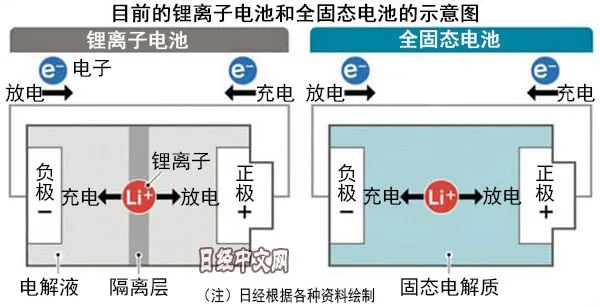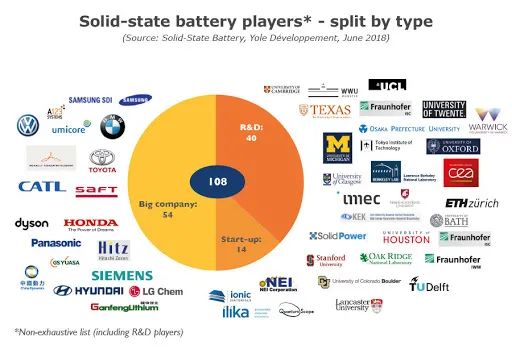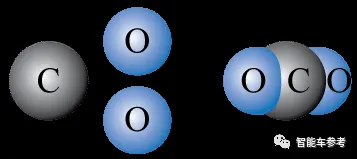Solid state battery is not a new concept, as early as in the 1970s has appeared in the last century, in 1991 or so solid state battery commercialization, the current headset in the use of miniature lithium batteries is a kind of solid state battery. At that time, the solid-state battery in the form of thin-film batteries, and at that time it was not popularized because of the solid-state thin-film batteries have a small capacity, high cost and other shortcomings, but it can be commercially applied, but also proved that the solid-state battery technology still has the feasibility.

With the gradual popularization of new energy vehicles and emerging applications such as Internet of Things, especially new energy vehicles, which have high requirements for range, safety, charging time, etc., batteries have become the key to the key. As traditional liquid lithium batteries are approaching their application limits, solid-state batteries are gradually entering the public eye.
Traditional liquid lithium battery because of its charging and discharging principle is known to the scientific community as the "rocking chair battery", rocking chair at both ends of the positive and negative poles of the battery, the middle of the liquid electrolyte. Lithium electrons in the rocking chair at both ends of the movement back and forth, in the lithium electrons from the positive pole to the negative pole of the process, the completion of the battery charging and discharging. In this process, there are many safety hazards, such as overcharging, the battery is easy to heat, resulting in electrolyte gas expansion, decomposition, spontaneous combustion and even explosion.
The charging and discharging principle of solid-state batteries is the same as that of liquid batteries, the only difference is that its electrolyte is solid, which has many advantages over liquid electrolytes: 1) High energy density. Solid-state batteries with solid electrolyte, there is no need to use embedded lithium graphite negative electrode, but directly use lithium metal as the negative electrode, which can reduce the amount of negative electrode materials, thereby improving the energy density of the battery. 2) Small size. Traditional liquid lithium batteries in the diaphragm and electrolyte occupies nearly 25% of the mass of the entire battery, the use of solid electrolyte, the distance between the positive and negative electrodes can be shortened to a minimum of more than a dozen microns, so that the battery's thickness and quality have been greatly reduced.3) Higher safety. Conventional batteries because the electrolyte is liquid, at high temperatures may occur in a series of safety hazards described above, while solid-state batteries do not have these problems, with a higher level of safety.
At present, many countries and regions around the world have been invested in solid-state battery research, especially for all-solid-state battery research. In October held the eighth battery new energy industry international summit forum, many domestic battery companies introduced their R & D status in the field of solid-state batteries, as well as the opportunities and challenges facing this field. Ganfeng Lithium believes that solid-state batteries can well meet the future development needs of new energy vehicles, they are currently working with the Chinese Academy of Sciences, Ningbo Institute of Materials, has a longer-term and comprehensive technical precipitation in solid-state battery technology, especially in the industrialization of solid-state batteries at the forefront of the industry. The batteries developed by the company have passed the comprehensive evaluation of many authoritative third parties, and have been docked with car companies for application. In addition, Suzhou Qingtao, Beijing Weilan New Energy and other companies in the solid-state battery research and development has also walked in the forefront of the world.

Solid State Battery Players Galore
Japanese companies are also in the field of solid-state batteries continue to force, including Hitachi Zosen, Fujitsu, TDK, and Toyota, Panasonic and other companies are actively laying out the field of solid-state batteries. Especially Panasonic, according to foreign media reports, Toyota and Panasonic in 2020 year out has cooperated to set up a joint venture - Prime Planet Energy & Solutions, will develop and produce prismatic lithium-ion batteries, as well as solid-state batteries and "next-generation" batteries. next-generation" batteries. In addition, it has developed a solid electrolyte lithium-ion rechargeable battery with a volumetric energy density of 425h/l in conjunction with Belgian research institute IMEC.
In addition to China and Japan, the United States, South Korea and other countries and regions also have layout in the field of solid-state batteries. Especially in the new energy automobile industry, solid-state batteries are considered to be the fundamental way to solve the safety problems of power batteries. In particular, in recent years, countries around the world for the automotive industry's environmental regulation is becoming increasingly stringent, according to incomplete statistics, there are more than 12 countries, 25 regions have announced or formulated a timetable for the ban on the sale of fuel vehicles. New energy vehicles instead of fuel vehicles will be the general trend. All-solid-state batteries, which can help overcome the problems of range, safety, and charging time, are the current focus. According to Fuji Economics forecasts, all-solid-state batteries will gradually expand their application from the mid-2020s, and the market size will reach about 2.8 trillion yen by 2035, surging from 330 billion yen in 2030.
However, the current all-solid-state battery technology is also facing many technical challenges, including solid interface issues, high-performance battery materials development and engineering issues, as well as raw materials and industrial manufacturing system has not yet formed a large-scale, as well as mass production costs and so on. The most important issue is that the current battery size for solid-state batteries, safety indicators and other aspects of the standard system has not been built. The full commercialization of solid-state batteries there is still a way to go, but I believe that under the impetus of many new applications, under the research and development efforts of companies in various fields, the large-scale popularization of solid-state batteries will soon come.
(Article source: Explore TechSugar)
[Zhongshun Xinneng Marketing Department January 6, 2021 Responsibility: Xiao Zheng]
* Reproduced for the purpose of transmitting more information, and does not mean that we endorse its views and are responsible for its authenticity.




